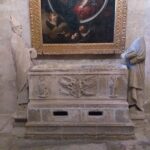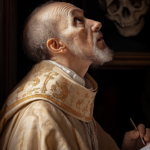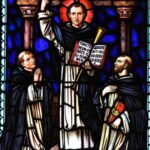St. John of the Cross
St. John of the Cross
St. John of the Cross: Unraveling the Mystical Journey of a Spiritual Luminary
When they lived:
St. John of the Cross, also known as San Juan de la Cruz, lived during the late 16th century. He was born on June 24, 1542, and departed from this world on December 14, 1591. His life was marked by profound spiritual experiences and a relentless pursuit of divine understanding.
Where they lived:
St. John of the Cross hailed from the enchanting landscapes of Old Castile in Spain. His birthplace, Fontiveros, a quaint village amidst picturesque vistas, played a significant role in shaping his spiritual disposition.
Notable world events during the time of their life:
- Exploration of the New World (1492 onwards): While St. John of the Cross was not directly involved in the expeditions, he lived in a time when the discovery of the New World was reshaping the global map and opening up vast opportunities for exploration and trade.
- Shakespearean Renaissance (late 16th century): The world was witnessing the golden age of English literature and theater during St. John’s lifetime. Playwrights like William Shakespeare were redefining storytelling and captivating audiences with timeless masterpieces.
- Scientific Revolution (16th and 17th centuries): As St. John delved into spiritual introspection, the world outside was experiencing significant strides in science and exploration. Visionaries like Galileo Galilei were challenging long-held beliefs, introducing new theories about the cosmos.
- Battle of Lepanto (October 7, 1571): This naval clash between the Holy League and the Ottoman Empire was a critical event in European history. The victory of the Holy League curtailed the expansion of the Ottomans in the Mediterranean and had far-reaching implications for the continent.
- Birth of the Tokugawa Shogunate (1603): Although St. John didn’t live to see it, the Tokugawa Shogunate in Japan was established in 1603, bringing an era of stability and peace after centuries of civil wars.
Their patronage:
St. John of the Cross is revered as the patron saint of mystics, contemplatives, and spiritual seekers. His extraordinary poems and writings, most notably “The Dark Night of the Soul” and “The Ascent of Mount Carmel,” have inspired countless individuals on their spiritual journeys. St. John’s teachings emphasize detachment from worldly desires and a profound union with the divine, making him an enduring beacon of spiritual enlightenment.
A Yearning of the Heart
St. John of the Cross, given the name Juan de Yepes y Alvarez, was born in 1542 in Fontiveros, a small village near Avila in Old Castille, Spain. His parents were Gonzalo de Yepes and Catalina Alvarez. Their family was very poor because Gonzalo, who was from a noble family in Tolde, had been disowned and thrown out of his home for marrying Catalina, who was a humble silk weaver. Catalino died when John was still young. His mother found work weaving, which helped her raise her children.
When he was 9 years old, John, his mother, and his brother moved to Medina del Campo, a center for commerce and culture not far from Valladolid. He attended the Colegio de los Doctrinos while he carried out menial tasks for the nuns of the Church and Convent of the Maddalena. Later on, because of his exceptional qualities and intelligence, he was admitted first as a male nurse to the Hospital of the Conception and then to the newly founded Jesuit College at Medina del Campo.
He went to college when he was 18. For three years, he studied humanities, classical languages, and rhetoric. Towards the end of his formation, John had a clear view of his vocation: he wanted to enter religious life. Among the many religious orders in Medina, he felt he was called to Carmel.
The Carmelite Journey
John began his novitiate with the Carmelites of Medina in the summer of 1563. He took the religious name Juan de Santo Matia (John of St. Matthias). The succeeding year, he went to the University of Salamanca, a prestigious center for studies, where he studied philosophy and the humanities for three years. In 1567, he was ordained to the priesthood and returned to Medina del Campo to celebrate his first Mass with his family.
There, John and Teresa of Jesus met for the first time. Teresa explained to him her plan for initiating a reform in Carmel, which included the male branch of the Order. John was so enthralled by Teresa’s ideas that he became a great supporter and champion of her endeavor.
John and Teresa worked together for several months, sharing ideas and proposals, aiming to start the first house of Discalced Carmelites as soon as possible. On December 28, 1568, it was opened in Duruelo, in the Province of Avila. The first reformed male community consisted of John and three other companions. Each of them took a new name, and it was from that time that John called himself “John of the Cross”.
Disorder within the Order
However, the reform of the order was not welcomed by all. In 1577, after being accused unjustly, John was seized and imprisoned in the Carmelite Convent of the Ancient Observance in Toledo. Imprisoned for months, John was subjected to physical and moral mistreatment. During his imprisonment, he composed the well-known Spiritual Canticle. In the night between August 16 and 17, 1578, he escaped and sought refuge at the Monastery of Discalced Carmelite Nuns in Toledo.
Teresa and her companions celebrated John’s freedom with great joy. After recovering, John was assigned to Andalusia, where he spent 10 years in different convents, especially in Granada. He was given more responsibilities in his order until he became vicar provincial and finished the draft of his spiritual treatises. Then he returned to his native land as a member of the General Government of the Teresian religious family, which already enjoyed full juridical autonomy.
His Final Years
John stayed in the Carmel of Segovia, where he served in the office of community superior. He was relieved of all responsibilities and was assigned to the new religious province of Mexico in 1591. While preparing for the long journey with his companions, he retired to a secluded convent near Jaén, where he fell seriously ill. He faced great suffering with serenity and peace. John of the Cross died between December 13 and 14, 1591. His remains were transferred to Segovia. He was beatified in 1675 by Pope Clement X and canonized in 1726 by Pope Benedict XIII. His feast day is December 14.
Five Interesting Facts About St. John of the Cross
- St. John of the Cross is the patron saint of mystics, contemplatives, and Spanish poets.
- St. John of the Cross was declared a Doctor of the Church in 1926 by Pope Pius XI. He is also called the “Mystical Doctor”.
- St. John of the Cross became an expert in the Bible. He dared to translate the Song of Songs into Spanish, an act that was controversial since the Church forbade the translation of the Bible from Latin.
- St. John of the Cross had a vision of Christ and made a drawing that remains to this day called “Christ from Above.” The little drawing shows Christ on the cross, looking down on him from above. The image has been preserved for centuries.
- One of St. John of the Cross’ celebrated works is the poem “Dark Night of the Soul”. This poem narrates the journey of the soul from its bodily home to its union with God.
Prayer to St. John of the Cross
O God, who gave the priest Saint John an outstanding dedication to perfect self-denial and love of the Cross, grant that, by imitating him closely at all times, we may come to contemplate eternally your glory. Through our Lord Jesus Christ, your Son, who lives and reigns with you in the unity of the Holy Spirit, one God, for ever and ever Amen.



